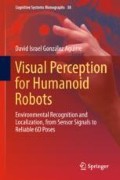Abstract
This chapter presents the environmental visual recognition method. A detailed presentation of the proposed method for extraction of 3D geometric-primitives is provided. The synergistic cue integration (homogeneity, edge and phase rim) for extraction of 2D geometric-primitives is presented. The consolidation of 3D geometric-primitives by calibrated stereo vision is introduced. The effectiveness and precision of the proposed method are experimentally evaluated with various natural and artificial illuminations on different environmental objects ranging from rather simple doors up to complex electric appliances.
Access this chapter
Tax calculation will be finalised at checkout
Purchases are for personal use only
Notes
- 1.
Demosaicing is the reconstruction of a color image based on partial color samples from a sensor using a color filter array such as the wide spread Bayer pattern.
- 2.
Factorized as a sum in the exponent of \(A_G(\mathbf x ,\mathbf x _i)\) in Eq. 5.1.
- 3.
Minimum object distance is the shortest distance between the lens and the subject.
References
Ayache, N. 1991. Artificial Vision for Mobile Robots. MIT Press. ISBN 978-0262011242.
Papari, G., and N. Petkov. 2011. Edge and Line Oriented Contour Detection: State of the Art. Image and Vision Computing 29 (3): 79–103.
Ramanath, R., and W. Snyder. 2003. Adaptive Demosaicking. Journal of Electronic Imaging 12: 633–642.
Keys, R. 1981. Cubic Convolution Interpolation for Digital Image Processing. IEEE Transactions on Acoustics, Speech and Signal Processing 29 (6): 1153–1160.
Grigorescu, C., N. Petkov, and M. Westenberg. 2003. Contour Detection based on Nonclassical Receptive Field Inhibition. IEEE Transactions on Image Processing 12 (7): 729–739.
Wang, X., W. Lin, and P. Xue. 2005. Demosaicing with Improved Edge Direction Detection. In IEEE International Symposium on Circuits and Systems 3: 2048–2051.
Hirakawa, K., and T. Parks. 2005. Joint Demosaicing and Denoising. In IEEE International Conference on Image Processing 3: 309–312.
Moriya, S., J. Makita, T. Kuno, N. Matoba, and H. Sugiura. 2006. Advanced Demosaicing Methods based on the Changes of Colors in a Local Region. In International Conference on Consumer Electronics, Digest of Technical Papers, 307–308.
Tomasi, C., and R. Manduchi. 1998. Bilateral Filtering for Gray and Color Images. In International Conference on Computer Vision, 839–846.
Lukin, A., and D. Kubasov. 2004. High-Quality Algorithm for Bayer Pattern Interpolation. Programming and Computer Software 30 (6): 347–358.
Hartley, R., and A. Zisserman. 2004. Multiple View Geometry in Computer Vision, 2nd ed. Cambridge: Cambridge University Press. ISBN 0521540518.
KIT. 2011. Karlsruhe Institute of Technology, Computer Science Faculty, Institute for Anthropomatics, The Integrating Vision Toolkit. http://ivt.sourceforge.net.
Zhang, Z. 2000. A Flexible New Technique for Camera Calibration. IEEE Transactions on Pattern Analysis and Machine Intelligence 22 (11): 1330–1334.
OpenCV. Open Source Computer Vision Library. http://opencv.org.
PTGrey. 2008. Dragonfly Technical Reference Manual. Accessed 5 Aug 2008.
Glasner, D., S. Bagon, and M. Irani. 2009. Super-resolution from a Single Image. In IEEE International Conference on Computer Vision, 349–356.
Park, S.C., M.K. Park, and M.G. Kang. 2003. Super-resolution Image Reconstruction: A Technical Overview. IEEE Signal Processing Magazine 20 (3): 21–36.
Canny, J. 1986. A Computational Approach to Edge Detection. IEEE Transactions on Pattern Analysis and Machine Intelligence 8 (6): 679–698.
Hart, P., N. Nilsson, and B. Raphael. 1968. A Formal Basis for the Heuristic Determination of Minimum Cost Paths. IEEE Transactions on Systems Science and Cybernetics 4 (2): 100–107.
Lowe, D. 1987. Three-Dimensional Object Recognition from Single Two-Dimensional Images. Artificial Intelligence 31: 355–395.
Sarkar, S., and K. Boyer. 1993. Perceptual Organization in Computer Vision: A Review and a Proposal for a Classificatory Structure. IEEE Transactions on Systems, Man and Cybernetics 23 (2): 382–399.
Grimson, W. 1990. Object Recognition by Computer: The Role of Geometric Constraints. Cambridge, MA, USA: MIT Press. ISBN 0262071304.
Wolfson, H., and I. Rigoutsos. 1997. Geometric Hashing: An Overview. IEEE Computational Science Engineering 4 (4): 10–21.
Vahrenkamp, N., T. Asfour, and R. Dillmann. 2012. Simultaneous Grasp and Motion Planning. IEEE Robotics and Automation Magazine, 43–57.
Author information
Authors and Affiliations
Corresponding author
Rights and permissions
Copyright information
© 2019 Springer Nature Switzerland AG
About this chapter
Cite this chapter
González Aguirre, D.I. (2019). Environmental Visual Object Recognition. In: Visual Perception for Humanoid Robots. Cognitive Systems Monographs, vol 38. Springer, Cham. https://doi.org/10.1007/978-3-319-97841-3_5
Download citation
DOI: https://doi.org/10.1007/978-3-319-97841-3_5
Published:
Publisher Name: Springer, Cham
Print ISBN: 978-3-319-97839-0
Online ISBN: 978-3-319-97841-3
eBook Packages: Intelligent Technologies and RoboticsIntelligent Technologies and Robotics (R0)

